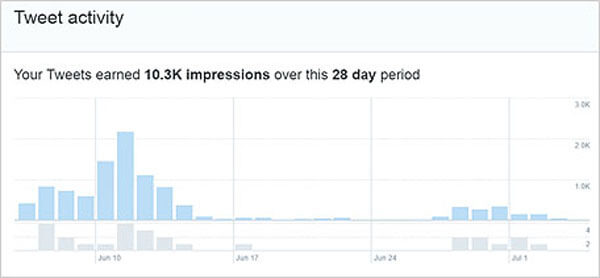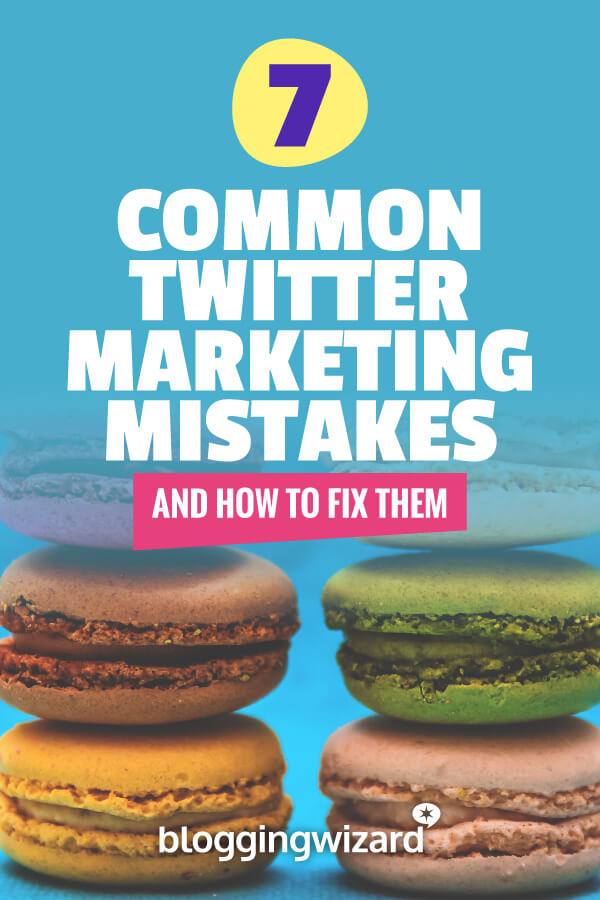7 Common Twitter Marketing Mistakes And How To Fix Them

As a business owner, you probably view Twitter as an integral part of your marketing strategy.
And for good reason.
Being active on the platform can boost your visibility while strengthening your brand. It can also help forge meaningful relationships with your target audience.
Twitter is a lot more flexible than other platforms like LinkedIn, so you can start conversations with peers, influencers, and potential business prospects on a whim.
But just because you’re active on Twitter doesn’t mean you’re optimizing your experience.
To be an effective Twitter user, you must steer clear of common pitfalls.
Read on for 7 common Twitter mistakes you might be making and their remedies.
1. Forgoing automation tools
You might be the type of person who tweets sporadically.
Perhaps you post to your timeline whenever you stumble upon interesting material or have your own content to share.
This isn’t the best strategy.
In today’s fast-paced digital world, your Twitter presence must be constant to stay top of mind.
Automation tools can aid you in achieving consistency with your social media posts.
Tools such as Buffer and IFTTT can streamline the posting process by allowing you to schedule your posts in advance.
Another useful thing about automation tools is that they’ll shorten your link URLS for you. This will make for a cleaner display. Here’s an example from Buffer:

Buffer even has a tool called the Buffer Extension that’ll allow you to share content as you browse the web.
And if you self-host on WordPress, you can also make use of the WordPress to Buffer plugin if you house a blog on your business website.
Having trouble finding shareable content?
Research the popular blogs and trade associations in your field. Set aside a couple of hours each week to read the articles they provide.
This is also an effective way to keep up-to-date with the latest developments in your industry.
Another useful way to find content is to browse hashtags relevant to your field. It’ll keep your Twitter feed fresh and expand the scope of your content sources.
2. Being too self-promotional
Social media should be more about giving than taking. And this is especially true for Twitter. So if you only show up to self-promote, this will rub your audience the wrong way.
Consider implementing the Rule of Thirds.
This approach dictates that you divide your content sharing strategy equally into three categories:
- Content that promotes your business and leads to conversions
- Content that focuses on personal interaction and brand building
- Content from influencers and peers in your respective industry
Adopting this strategy has many benefits.
For one, you’ll begin to build trust with your audience if you become an engaged member of the Twitter community.
This will make people more receptive to the content you share, inching them closer to converting when you promote your business.
It’ll also make people eager to reciprocate your goodwill by sharing your brand’s content with their following. These valuable shares will expand your reach.
And when it comes to sharing the content of others, don’t limit yourself to educational articles.
Motivational quotes are a great way to catch the eye of your followers.
Users in your niche have an abundance of informational business articles gracing their timelines, so offering a bit of motivation or inspiration will help you stand out.
It’s also a way you can add depth to your personal brand.
If you’re looking for an efficient way to share quotes, consider using the automation tool Social Jukebox. It allows you to create jukeboxes filled with posts you can share with your Twitter following.
Each plan includes a complimentary jukebox containing 200 quotes. Plus, you’ll have access to the Jukebox Library, which has jukeboxes stocked with motivational quotes you can add to your queue.
You can choose to use these quotes for targeted days (think #MondayMotivation and #WednesdayWisdom) or schedule them throughout the week.
3. Not leveraging Twitter lists
Twitter lists are a tool you can use to keep tabs on a curated group of people. You can either create your own or subscribe to ones created by others.
They’re especially handy if you follow a lot of people and businesses or if you want to keep tabs on a group of users without becoming a follower.
To create a Twitter list, you can go to your profile and click Lists:

From there, you can hit Create new list on the right-hand side of the page.
Your next step is to name your list and save it. You also have the option of making it public or private.
Need ideas for the kinds of lists you can create?
Some viable options include:
- Industry influencer lists
- Niche news outlet lists
- Industry peer lists
- Competitor lists
- Client lists
Subscribing to lists is also a painless process. You can visit the profiles of people that interest you and browse their list offerings, subscribing to those that catch your eye.
4. Neglecting your header image
As a business owner, your social media platforms provide ample opportunity to showcase what your brand is all about.
Twitter is no different.
While a memorable Twitter profile blurb can do wonders, a picture is worth a thousand words.
Creating a branded Twitter header is a smart way to catch the eye of the people who visit your profile. You can use this prime real estate as free advertising to promote your business to your target audience.
And don’t think it’s tacky to self-promote in this manner. You can create tasteful banners that reflect your brand using online platforms like Canva.
Elna Cain, a freelance writer and entrepreneur, provides an excellent example of a branded Twitter header.
She uses one Twitter account as a platform for her two blogs – Elna Cain and Twins Mommy:

Anyone that visits her page will instantly know what she’s all about.
Don’t want to use your Twitter header as a billboard?
There are other ways you can go about optimizing your header. You could incorporate an image or catchphrase that ties in nicely with your brand.
If you’re more of a minimalist, you can choose a header color that ties in nicely with your brand.
5. Relying solely on automation tools
As we previously discussed in our first talking point, automation tools are a critical part of your Twitter strategy.
But that doesn’t mean you should let your Twitter account run on autopilot.
You want to assure your following that an actual person is running your account.
Check up on your account at least once a day to stay up-to-date with what’s happening. Make it a habit of liking and retweeting compelling tweets from your timeline.
And when people like or share your content, show your appreciation. Rather than simply liking or retweeting their tweets, consider replying to them with a note of thanks. It’ll make you stand out and can open a dialogue.
Plus, you never know where that dialogue will lead.
6. Failing to conduct hashtag research
In the same way you conduct keyword research for your website content and ads, you should be doing this for Twitter hashtags.
Anything more than two hashtags is overkill, so you want to pick your hashtags with laser precision.
Using the right hashtags will increase the likelihood that people outside your following see and share your tweets, as many users use hashtags as a means of discovery.
One of the standout hashtag research tools for Twitter is Hashtagify. It provides key insights on targeted hashtags and has both free and paid versions:

Data you can access with the free version includes:
- Popularity trends by month and week
- Top influencers using a hashtag
- A related hashtag list
Other useful insights include top countries and languages. You also have access to the Tweets Wall, which will give you a snapshot of the Twitter accounts using the targeted hashtag.
You can further optimize your Twitter strategy by purchasing a plan starting at $19.
Some of the perks of a premium Hashtagify plan include:
- An expansive list of the top influencers for each tracked hashtag
- The ability to bookmark your favorite hashtags
- Hashtag suggestions for your Twitter posts
What’s nice about this tool is that it allows you to track influencers in your field as well as monitor the competition.
You can also use it to unearth new users to connect with.
7. Not tracking Twitter metrics
With all the tasks you must execute to keep your business afloat, it’s easy to let certain things slip through the cracks.
While it’s tempting to schedule your tweets and pray for the best, you should be analyzing what’s going on with those tweets.
Twitter Analytics is a valuable (and free) tool you can leverage to monitor the effectiveness of your tweets:

It’ll provide you with a 28-day snapshot of important metrics including:
- Number of profile visits
- New follower count
- Mentions
But that’s not all.
The tool also offers fine-grained info for Tweets and Audiences.
You can get a snapshot of the number of impressions and engagements each tweet receives along with the engagement rate. You can also view your top performing tweets.
This will help you fine-tune your posting strategy. You can replicate the formula of your successful tweets and gauge what content resonates best with your audience.
As for Audience stats, you can view the main interests of your organic audience and use that info to incorporate those interests into your tweets.
If you’re looking for more options to track your social media metrics, you can sign up for paid plans of Buffer or Hootsuite.
Wrapping up
Leveraging Twitter’s 330 million monthly active users correctly can help your business flourish, so it’s worth putting in some time and effort into proper implementation.
You can take control of optimizing your Twitter strategy by sticking to these 7 guidelines:
- Embrace automation
- Mix your content
- Leverage Twitter lists
- Utilize your profile header
- Interact on a daily basis
- Include relevant hashtags
- Track your performance
And don’t worry if you’re making any of the mistakes we’ve discussed.
The great thing about Twitter is that it’s easy to change course.
Related reading:

